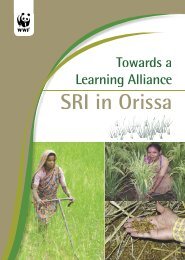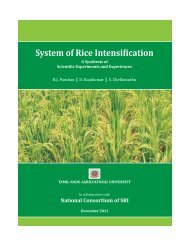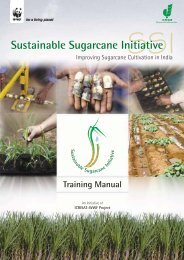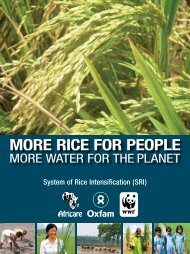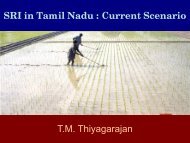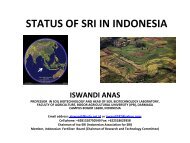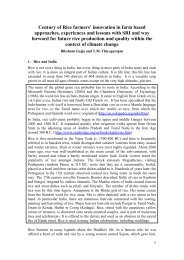SSI Newsletter - SRI - India
SSI Newsletter - SRI - India
SSI Newsletter - SRI - India
You also want an ePaper? Increase the reach of your titles
YUMPU automatically turns print PDFs into web optimized ePapers that Google loves.
Speaking about the various inter<br />
crops that can be sown along with<br />
cane, Anji Reddy says, “French beans<br />
can be sown in June and Potato<br />
in October. Though sugarcane<br />
cultivation is becoming more and<br />
more risky, through the <strong>SSI</strong> method<br />
and intercropping, there is much less<br />
expenditure, in spite of the hike in<br />
prices of almost every commodity<br />
today. While the cane seedlings are<br />
getting ready in the nursery, the<br />
intercrop can be sown in between the<br />
rows. If the soil is black cotton soil,<br />
then soya bean is a very good option.<br />
There is a yield of at least Rs. 25, 000<br />
to Rs.30,000 from the potato crop,<br />
which is a bonus to the income from<br />
the sugarcane harvest. The total cost<br />
of cultivation under <strong>SSI</strong> does not cross<br />
beyond 10 to 15 Thousand Rupees.”<br />
“Two legume crops, if sown, can fetch<br />
up to 5 to 10 Thousand Rupees per<br />
acre. In a cycle of one sugarcane crop<br />
– which is the principle crop – musk<br />
melon can be sown, to be harvested<br />
within the first 60 to 90 days. Then,<br />
in the 6 feet wider spacing, ginger<br />
or green chillies can be sown and<br />
these can be harvested at the end of<br />
6 - 8 months. This list of intercrops<br />
can also include paddy, pigeon pea,<br />
all varieties of vegetables, etc. So,<br />
totally, in 11 months, 2 intercrops can<br />
be cultivated.”<br />
Fertilizers – Chemical to<br />
Organic<br />
“Since I began to follow the <strong>SSI</strong><br />
method, I was able to reduce the<br />
usage of fertilizers by as much as<br />
50%. Instead of randomly sprinkling<br />
the fertilizer all over the crop in the<br />
field, I mixed the fertilizer in the water<br />
that was released to the crop through<br />
the drip irrigation. This ensured<br />
that fertilizer reached the roots of<br />
each plant, which is the aim of the<br />
application. Another option for the<br />
farmer is to make a small deep hole<br />
near each of the plants and put the<br />
fertilizer in this hole for it to reach<br />
the roots directly.”<br />
Water – Saved and<br />
Regenerated<br />
“I save nearly 50% of water in 1 acre<br />
when compared to the conventional<br />
method. Water gets saved right<br />
from the time of raising the nursery.<br />
The amount of water that goes into<br />
irrigating 1 acre of land under flood<br />
irrigation can actually be used for 2<br />
acres of cane and intercrops now. The<br />
drip system that I have installed is<br />
working very well with the intercrops<br />
as well”.<br />
Fruits of Success are Sweet<br />
Indeed!<br />
Anji Reddy says, “I am able to get a<br />
clear profit of around 15 Thousand<br />
Rupees per acre on an average, after<br />
all the costs are paid off. The money<br />
is saved at every level, when buying<br />
seed, when buying fertilizers, and<br />
there is a reduction in 50% of labor<br />
wages. Added to all this, the yield is<br />
doubled.<br />
Compared to my earlier yield of 30<br />
to 40 tonnes, today I can get even<br />
100 tonnes per acre. The number of<br />
millable tillers has increased from<br />
2-4 to 10-15 per plant. The girth of<br />
the cane has also increased manifold.<br />
And this became possible because of<br />
the <strong>SSI</strong> methods”.<br />
Manisha Agarwal is the<br />
Communication Officer for<br />
ICRISAT-WWF project.<br />
Nov ‘09<br />
21<br />
SugarCane<br />
matters





